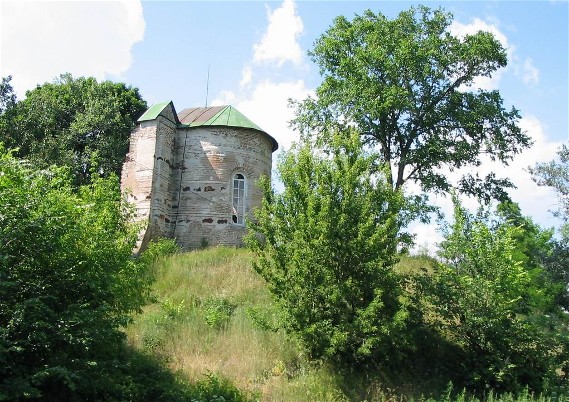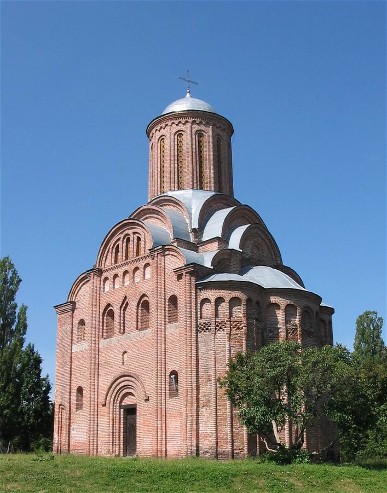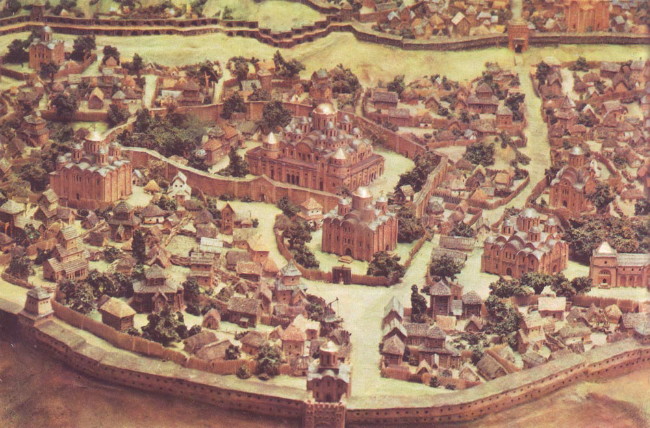Kyivan Rus’
Kyivan Rus’ [Київська Русь; Kyivska Rus]. (Map: Kyivan Rus'.) The first state to arise among the Eastern Slavs. It took its name from the city of Kyiv, the seat of the grand prince from about 880 until the beginning of the 13th century. At its zenith, it covered a territory stretching from the Carpathian Mountains to the Volga River, and from the Black Sea to the Baltic Sea. The state's rapid rise and development was based on its advantageous location at the intersection of major north-south and east-west land and water trade routes with access to two major seas, and favorable local conditions for the development of agriculture. In the end, however, the state's great size led to the development of centrifugal tendencies and local interests that limited its political and social cohesion. This, and its proximity to the Asian steppes, which left it vulnerable to invasions of nomadic hordes, eventually contributed to the decline of Kyivan Rus’.
In the 8th century, the territory of Kyivan Rus’ was inhabited by a number of tribes who shared a common proto-Slavic language, pagan beliefs, and life-style. The ancestors of the Ukrainians included the Polianians, Siverianians, Derevlianians, Dulibians, White Croatians, Ulychians, and Tivertsians. The proto-Russian Krivichians, Viatichians, and Radimichians and the proto-Belorussian Drehovichians also lived on the lands that eventually constituted Kyivan Rus’. The Polianians were the largest and most developed of the tribes; according to the Rus’ Primary Chronicle, their prince Kyi founded the city of Kyiv in the 6th century. None of the tribes, however, was able to create a viable state, and in the 9th century the Varangians from Scandinavia conquered the tribes and laid the groundwork for the Kyivan Rus’ state.
History. According to some sources, the first Varangian rulers of Rus’ were Askold and Dyr. In 882 they were killed by Prince Oleh, the son of Riuryk of Novgorod. From that time, descendants of the Riurykide dynasty ruled Kyivan Rus’ and other east-European territories until 1596.
Prince Oleh was soon able to consolidate his rule in Kyiv and defeated the Khazars, who had been threatening the individual tribes from the east. In 907 he led a campaign against Constantinople and four years later concluded an important trade agreement that laid the basis for a permanent relationship between Rus’ and the Byzantine Empire. Oleh's son Prince Ihor (912–45) expanded the territory under his control to include the northern Pontic littoral. His attempts to extend his rule over all of the tribes in the region, however, were resisted and he was eventually killed by the Derevlianians, who refused to pay him tribute. His widow Princess Olha (945–62) ruled as regent until their son came of age. She was the first Rus’ ruler to convert to Christianity and to establish direct ties with central and western-European rulers. The reign of Sviatoslav I Ihorovych (962–72) was marked by almost uninterrupted warfare. Known as ‘the Conqueror,’ Sviatoslav Ihorovych attempted to expand his territory to the Danube River, defeating the Bulgarians and establishing Pereiaslavets on the Danube.
If the first period of Kyivan Rus’ history can be characterized as the era of expansion, which saw Kyiv extend its authority over all of the east-Slavic tribes and witnessed the attempts of the rulers to expand their realm to the Danube River and Volga River basins, then the second period, beginning with the reign of Yaropolk I Sviatoslavych (972–80), may best be described as the era of internal consolidation. However, it was under Yaropolk's brother Volodymyr the Great, who seized power with the help of Varangian mercenaries and killed his brother in 980, that Kyivan Rus’ became one of the pre-eminent states of Europe. The most important achievement of Volodymyr's rule was the adoption of Christianity in 988 as the official religion of Rus’ (see Christianization of Ukraine), which facilitated the spread of Byzantine culture throughout the state (see Byzantine art, Byzantine law) and served to reinforce the political unity and cultural cohesion of Rus’.
After Volodymyr the Great's death in 1015, his son Sviatopolk I seized power, but he was opposed in a bitter internecine war. Sviatopolk was initially helped by the Polish prince Bolesław I the Brave, who took the opportunity to capture the Cherven towns from Rus’; however, when he abandoned this alliance, his brother Yaroslav the Wise, aided by an army of Varangians, captured Kyiv. A second series of wars ensued between Yaroslav the Wise and his brother Mstyslav Volodymyrovych, who had developed an important power base as prince of Tmutorokan. The two brothers ruled jointly until Mstyslav died in 1036 without an heir, leaving Yaroslav the Wise as grand prince of a reunited Rus’. Yaroslav the Wise's reign as unchallenged grand prince (1036–54) was one of the highest points in the history of Rus’. The process of internal consolidation begun earlier was greatly furthered by Yaroslav the Wise's codification of the law in Ruskaia Pravda. Culture flourished: the magnificent Saint Sophia Cathedral was built in Kyiv, the Kyivan Cave Monastery was founded, a library was established, and learning and education were encouraged. Yaroslav the Wise also appointed the first local hierarch as Kyivan metropolitan (see Metropolitan Ilarion), thus asserting Kyiv's independence of Constantinople. Yaroslav's death initiated another round of civil war and internecine struggle, although he had tried to prevent this effect by preparing a plan for dividing up political power between his sons and re-establishing the seniority-rotation system devised by Volodymyr the Great. By this time, the interests of the individual princes were too disparate to be easily reconciled and none respected the others' domains or the ultimate authority of the Kyivan prince. The situation was further complicated by the presence of the Cumans, who in the middle of the 11th century had replaced the Pechenegs on the southern border of Rus’. For the next century and a half they waged continuous war against Rus’ and became involved in the internecine wars, serving as allies of one branch of the dynasty or another. The princes attempted to solve their differences in a series of conferences, especially the Liubech congress of princes in 1097, which altered the patrimonial system of decreeing that sons could rightfully inherit their father's lands, although they would all respect the authority of the Kyivan prince. All of these solutions were short-lived, however, and the civil wars continued.
A brief respite occurred during the reign of Volodymyr Monomakh. Under Volodymyr Monomakh (1113–25) Kyiv once again flourished and the internecine wars abated. Ruskaia Pravda was amended (see Volodymyr Monomakh's Statute), and several valuable works of literature, hagiography, and historiography were composed, including the important Kyivan Cave Patericon. Volodymyr Monomakh himself wrote his famous testament Poucheniie ditiam, in which he told his sons how to be just and powerful rulers. His son Mstyslav I Volodymyrovych (1125–32) inherited the principal lands of Rus’, while the remaining territories were distributed among his brothers. Neither Mstyslav nor his brother and successor in Kyiv, Yaropolk II Volodymyrovych (1132–9), was able to prevent the dynastic rivalry for the title of ‘grand prince of Kyiv and all Rus’.’ The Kyivan Rus’ federation continued to disintegrate and Kyiv itself lost its primacy: the city was sacked several times by feuding princes, most notably in 1169 by Andrei Bogoliubskii of Vladimir, Rostov, and Suzdal. The Kyiv principality, Polatsk principality, Turiv-Pynsk principality, Volodymyr principality, Halych principality, Chernihiv principality, and Pereiaslav principality emerged as independent and separate entities, with their own political and economic peculiarities, as did Novgorod the Great, Suzdal, Vladimir, and others that later constituted Muscovy and then Russia. The quarreling between the princes left Rus’ vulnerable to foreign attacks, and the invasion of the Mongols in 1236–40 finally destroyed the state. The principalities never organized a common defense, and in turn each was conquered and pillaged. Kyiv was thoroughly sacked in 1240 and reduced to a shadow of its former self.
Origins. The question of the origins of Kyivan Rus’ still produces controversy among historians. The oldest, or Normanist theory rests mainly on a literal interpretation of the Primary Chronicle and stresses the role of the Varangians as the first leaders and organizers of the state. Ukrainian historians, beginning with Mykhailo Maksymovych and followed by Mykola Kostomarov, Volodymyr Antonovych, Mykhailo Hrushevsky, Dmytro Bahalii, Dmytro Doroshenko, Mykola Chubaty, and others, have generally downplayed the Varangian influence on the formation of Rus’. The Soviet historiography categorically rejected the Normanist theory, considering it bourgeois. However, it remains, with certain modifications, the basis of Western historiography of Russia and Ukraine.
The issue of the nationality of the inhabitants of the Kyivan state is also a matter of continuing controversy. The discussion was initiated by the Russian historian Mikhail Pogodin, who claimed that the original inhabitants of contemporary Ukraine fled north under pressure from the Mongols, and that they later became the modern Russian nation. The Ukrainians, meanwhile, arrived much later from somewhere in the Carpathian Mountains. Pogodin's views were expanded on by the philologist Aleksei Sobolevsky. This theory was disputed by Ukrainian historians such as Mykhailo Maksymovych, Mykola Dashkevych, Pavlo Zhytetsky, and Ahatanhel Krymsky. Mykhailo Hrushevsky sought to demonstrate that Ukrainians were autochthonous in their territories, and that the Principality of Galicia-Volhynia was the successor to the Kyivan state. Hrushevsky's theories were for the most part adopted by Ukrainian historians and by some others. Because these theories did not correspond to the political objectives of the Soviet leadership, a panel of historians was commissioned in the 1930s by the Communist Party of the Soviet Union to draw up a new historical schema of Eastern Europe; its basic premise was that Kyivan Rus’ had been founded by a single old-Rus’ nationality, out of which Ukrainians, Russians, and Belarusians developed in the 14th and 15th centuries. This theory was given official approbation with the publication of Tezy pro 300-richchia vozz'iednannia Ukraïny z Rosiieiu, 1654–1954 (Theses about the 300th Anniversary of the Reunification of Ukraine with Russia, 1954). The émigré Ukrainian scholarship based itself on Hrushevsky's approach, and continued to expand its corollaries along historical (Mykola Chubaty, Nataliia Polonska-Vasylenko, M. Zhdan, Omeljan Pritsak), archeological (Yaroslav Pasternak), and linguistic (Stepan Smal-Stotsky, George Yurii Shevelov) lines.
The political and social institutions of Kyivan Rus’. From the 10th to the 12th century the Kyivan state underwent significant sociopolitical changes. Its original component tribes had no political tradition, and its first rulers viewed their domain simply as an object of exploitation, at best as a clan possession. Volodymyr the Great was the first ruler to give Rus’ political unity, by way of organized religion. The church provided him with the concepts of territorial and hierarchical organization; Byzantine notions of autocracy were adopted by him and his successors to give them the equivalent of imperial authority. The political traditions introduced by Volodymyr were based on the principles of territorial indivisibility and dynastic sovereignty. The seniority system of rule—ascension from elder brother to younger and from the youngest uncle to the eldest nephew—provided the Riurykide dynasty with a rotating system of advancement of its members, gave them political experience in lands they could someday expect to rule from Kyiv, and assured control, by way of traditional sanctions, of key points of the realm. This system served well until the reign of Volodymyr Monomakh, but did not survive Kyiv's decline.
The power of the grand prince was maintained by his military strength, particularly that of his druzhyna, or retinue. Ideologically, his power was upheld by the church, whose teachings gave him the attributes and responsibilities of a national leader, judge, and first Christian of the realm. The grand prince ruled and dispensed justice with the help of viceroys appointed by him, who were often the sons of the grand prince, of other princes, of governors, or of military commanders. These representatives of the grand prince's central power were aided by local administrators—the desiatski (see Desiatskyi). The grand prince consulted on important state matters with the Boyar Council, which consisted of his senior retainers and the local aristocracy of power and wealth.
The viche (assembly), an important organ already within the tribal network, resolved all matters on behalf of the population. The city viche, composed of freemen, decided mainly on questions of war and peace and on the invitation, recognition, or expulsion of a prince. It became particularly important in the 12th century during the internecine wars of the princes for the throne of Kyiv.
In the Princely era, Ukrainian society had its own peculiarities. Its privileged elite (the boyars and the ‘better people’), which enjoyed full protection of the law, was not a closed estate; based, as it was, on merit, which the prince rewarded with grants of land, its membership was dependent on the will of the prince. Thus even priests' sons and commoners could become boyars. The towns folk consisted of burghers—mostly merchants and crafts people—and paupers. There was little difference in status between the wealthy merchants and the landed boyars. Most freemen were yeomen called smerds, who lived on their own land or on the land of the prince, paid taxes, and performed certain duties, such as building fortifications, bridges, and roads and serving in the levy en masse in times of war; gradually the smerds became dependent on their lords, and some became tenants or hired laborers on the land. A smaller category of peasants consisted of zakups—impoverished smerds who had become indentured and half-free. The lowest social stratum in Rus’ consisted of slaves. Male slaves were called kholopy; usually prisoners of war or the offspring of slaves, they had no rights as persons and were considered the legal, movable property of their masters. Certain churchmen and princes, eg, Volodymyr Monomakh in Volodymyr Monomakh's Statute, tried to improve the lot and legal status of the slaves.
The economy of Kyivan Rus’. Relatively little is known about the economy of Kyiv, although there is no doubt that agriculture was the main activity of the inhabitants. Farming techniques and implements were naturally primitive and the peasants lived mostly at a subsistence level. Some animal husbandry was practiced, as was extensive grain cultivation. Land, particularly after the 11th century, was privately owned. Most peasants supplemented their agricultural activities with fishing, trapping, and hunting, especially in the northern forest and forest-steppe regions. The forests also supplied wood, the major source of fuel. The peasants generally lived in small, scattered villages.
The second major component of Kyiv's economy was foreign trade. Not only were local goods, particularly furs, traded for important items, but much profit was made from the simple transshipment of goods along the great trade routes linking first east and west and later north and south. In the end, it was the breakdown of the trade route from ‘the Varangians to Byzantium’ (see Varangian route) that partially initiated Kyiv's decline, and it was the emergence of specialized routes linking the northern principalities to the Hanseatic League of states that furthered the disintegration of the state.
BIBLIOGRAPHY
Hrushevs’kyi, M. Istoriia Ukraïny-Rusy, vols 1–3 (Lviv 1898–9)
Grekov, B. Kievskaia Rus’ (Moscow 1949; English trans Kiev Rus [Moscow 1959])
Paszkiewicz, H. The Origin of Russia (London 1954)
Vernadsky, G. The Origins of Russia (New Haven 1959)
Rybakov, B. Drevnaia Rus’ (Moscow 1963)
Shekera, I. Mizhnarodni zv'iazky Kyïvs’koï Rusi (Kyiv 1963)
Chubatyi, M. ‘Kniazha Rus’-Ukraïna ta vynyknennia tr’okh skhidn’o-slovians’kykh natsii,’ in ZNTSh, vol 178 (New York–Paris 1964)
Polons’ka-Vasylenko, N. Dvi kontseptsiï istoriï Ukraïny i Rosiï (Munich 1964; English trans Two Conceptions of the History of Ukraine and Russia [London 1968])
Braichevs’kyi, M. Pokhodzhennia Rusi (Kyiv 1968)
Pashuto, V. Vneshniaia politika Drevnei Rusi (Moscow 1968)
Froianov, I. Kievskaia Rus’: Ocherki sotsial’no-politicheskoi istorii (Leningrad 1980)
Tolochko, P. Kiev i Kievskaia zemlia v epokhu feodal’noi razdroblennosti XII–XIII vekov (Kyiv 1980)
Pritsak, O. The Origin of Rus’, vol 1 (Cambridge, Mass 1981)
Rybakov, B. Kievs’kaia Rus’ i russkie kniazhestva XII–XIII vekov (Moscow 1982)
Rybakov, B.; Selov, V. Vostochnye slaviany v VI–XIII vv. (Moscow 1982)
Gumilev, L. Drevnaia Rus’ i Velikaia step’ (Moscow 1989)
Dimnik, M. The Dynasty of Chernigov 1054–1146 (Toronto 1994)
Franklin, S.; Shepard, J. The Emergence of Rus’: 750–1200 (London–New York 1996)
Tolochko, P. Kyïvs’ka Rus' (Kyiv 1996)
Hrushevsky, Mykhailo. History of Ukraine-Rus', vol 1, From Prehistory to the Eleventh Century (Edmonton–Toronto 1997)
Pelenski, J. The Contest for the Legacy of Kievan Rus’ (Boulder, Colo 1998)
Tolochko, Oleksii; Tolochko, Petro. Kyïvs’ka Rus’ (Kyiv 1998)
Franklin, Simon. Byzantium—Rus'—Russia: Studies in the Transition of Christian Culture (Aldershot, UK, and Burlington, Vt, 2002)
Hrushevsky, Mykhailo. History of Ukraine-Rus', vol 2, The Eleventh to Thirteenth Centuries (Edmonton–Toronto 2021)
Mykhailo Zhdan
[This article originally appeared in the Encyclopedia of Ukraine, vol. 2 (1988). The bibliography has been updated.]

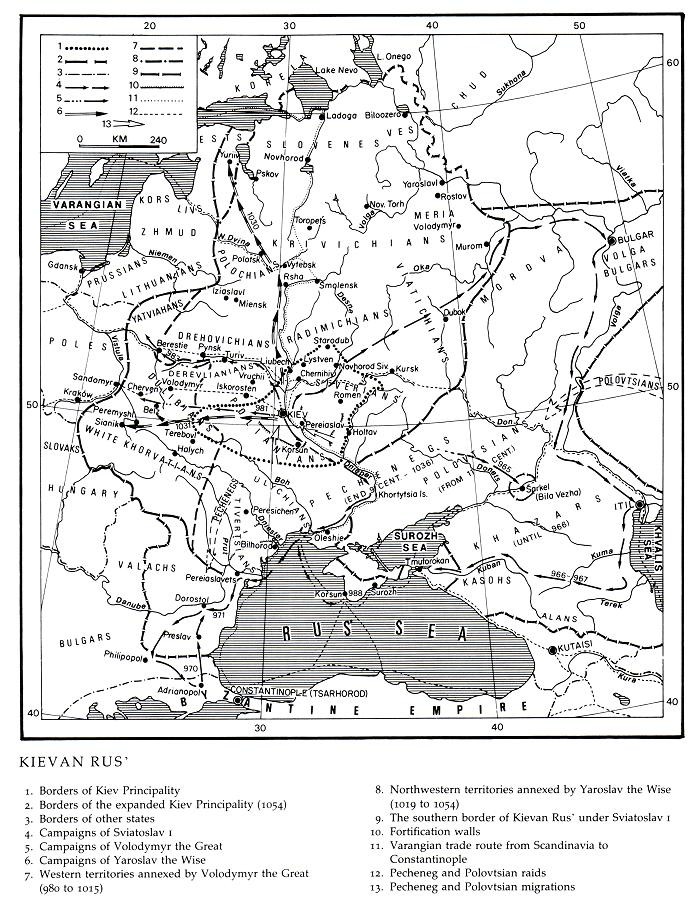
.jpg)
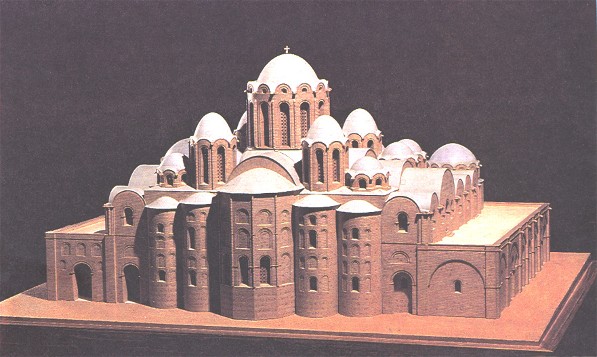
.jpg)
.jpg)
